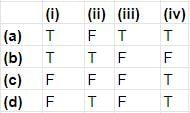NEET Exam > NEET Tests > NCERTs at Fingertips: Textbooks, Tests & Solutions > Test: Micturition (NCERT) - NEET MCQ
Test: Micturition (NCERT) - NEET MCQ
Test Description
5 Questions MCQ Test NCERTs at Fingertips: Textbooks, Tests & Solutions - Test: Micturition (NCERT)
Test: Micturition (NCERT) for NEET 2025 is part of NCERTs at Fingertips: Textbooks, Tests & Solutions preparation. The Test: Micturition (NCERT) questions and answers have been
prepared according to the NEET exam syllabus.The Test: Micturition (NCERT) MCQs are made for NEET 2025 Exam. Find important
definitions, questions, notes, meanings, examples, exercises, MCQs and online tests for Test: Micturition (NCERT) below.
Solutions of Test: Micturition (NCERT) questions in English are available as part of our NCERTs at Fingertips: Textbooks, Tests & Solutions for NEET & Test: Micturition (NCERT) solutions in
Hindi for NCERTs at Fingertips: Textbooks, Tests & Solutions course. Download more important topics, notes, lectures and mock
test series for NEET Exam by signing up for free. Attempt Test: Micturition (NCERT) | 5 questions in 5 minutes | Mock test for NEET preparation | Free important questions MCQ to study NCERTs at Fingertips: Textbooks, Tests & Solutions for NEET Exam | Download free PDF with solutions
Test: Micturition (NCERT) - Question 1
What will happen if the stretch receptors of the urinary bladder wall are totally removed?
Detailed Solution for Test: Micturition (NCERT) - Question 1
Test: Micturition (NCERT) - Question 2
Which one of the following is correct for a normal human?
Detailed Solution for Test: Micturition (NCERT) - Question 2
Test: Micturition (NCERT) - Question 3
Consider the following four statements (i) - (iv) and select the option that correctly identifies the true (T) and false (F) ones.
(i) Micturition is carried out by a reflex.
(ii) ADH helps in water elimination making the urine hypotonic.
(iii) Protein-free fluid is filtered from blood plasma into the Bowman's capsule.
(iv) Glucose is actively reabsorbed in the proximal convoluted tubule.

(i) Micturition is carried out by a reflex.
(ii) ADH helps in water elimination making the urine hypotonic.
(iii) Protein-free fluid is filtered from blood plasma into the Bowman's capsule.
(iv) Glucose is actively reabsorbed in the proximal convoluted tubule.

Detailed Solution for Test: Micturition (NCERT) - Question 3
Test: Micturition (NCERT) - Question 4
A person who is not taking food or beverages will have _____ in urine.
Detailed Solution for Test: Micturition (NCERT) - Question 4
Detailed Solution for Test: Micturition (NCERT) - Question 5
|
257 docs|234 tests
|
Information about Test: Micturition (NCERT) Page
In this test you can find the Exam questions for Test: Micturition (NCERT) solved & explained in the simplest way possible.
Besides giving Questions and answers for Test: Micturition (NCERT), EduRev gives you an ample number of Online tests for practice




















